Tong Che
Your Reward Function for RL is Your Best PRM for Search: Unifying RL and Search-Based TTS
Aug 19, 2025Abstract:Test-time scaling (TTS) for large language models (LLMs) has thus far fallen into two largely separate paradigms: (1) reinforcement learning (RL) methods that optimize sparse outcome-based rewards, yet suffer from instability and low sample efficiency; and (2) search-based techniques guided by independently trained, static process reward models (PRMs), which require expensive human- or LLM-generated labels and often degrade under distribution shifts. In this paper, we introduce AIRL-S, the first natural unification of RL-based and search-based TTS. Central to AIRL-S is the insight that the reward function learned during RL training inherently represents the ideal PRM for guiding downstream search. Specifically, we leverage adversarial inverse reinforcement learning (AIRL) combined with group relative policy optimization (GRPO) to learn a dense, dynamic PRM directly from correct reasoning traces, entirely eliminating the need for labeled intermediate process data. At inference, the resulting PRM simultaneously serves as the critic for RL rollouts and as a heuristic to effectively guide search procedures, facilitating robust reasoning chain extension, mitigating reward hacking, and enhancing cross-task generalization. Experimental results across eight benchmarks, including mathematics, scientific reasoning, and code generation, demonstrate that our unified approach improves performance by 9 % on average over the base model, matching GPT-4o. Furthermore, when integrated into multiple search algorithms, our PRM consistently outperforms all baseline PRMs trained with labeled data. These results underscore that, indeed, your reward function for RL is your best PRM for search, providing a robust and cost-effective solution to complex reasoning tasks in LLMs.
Two Heads are Better Than One: Test-time Scaling of Multi-agent Collaborative Reasoning
Apr 14, 2025Abstract:Multi-agent systems (MAS) built on large language models (LLMs) offer a promising path toward solving complex, real-world tasks that single-agent systems often struggle to manage. While recent advancements in test-time scaling (TTS) have significantly improved single-agent performance on challenging reasoning tasks, how to effectively scale collaboration and reasoning in MAS remains an open question. In this work, we introduce an adaptive multi-agent framework designed to enhance collaborative reasoning through both model-level training and system-level coordination. We construct M500, a high-quality dataset containing 500 multi-agent collaborative reasoning traces, and fine-tune Qwen2.5-32B-Instruct on this dataset to produce M1-32B, a model optimized for multi-agent collaboration. To further enable adaptive reasoning, we propose a novel CEO agent that dynamically manages the discussion process, guiding agent collaboration and adjusting reasoning depth for more effective problem-solving. Evaluated in an open-source MAS across a range of tasks-including general understanding, mathematical reasoning, and coding-our system significantly outperforms strong baselines. For instance, M1-32B achieves 12% improvement on GPQA-Diamond, 41% on AIME2024, and 10% on MBPP-Sanitized, matching the performance of state-of-the-art models like DeepSeek-R1 on some tasks. These results highlight the importance of both learned collaboration and adaptive coordination in scaling multi-agent reasoning. Code is available at https://github.com/jincan333/MAS-TTS
LoR-VP: Low-Rank Visual Prompting for Efficient Vision Model Adaptation
Feb 04, 2025Abstract:Visual prompting has gained popularity as a method for adapting pre-trained models to specific tasks, particularly in the realm of parameter-efficient tuning. However, existing visual prompting techniques often pad the prompt parameters around the image, limiting the interaction between the visual prompts and the original image to a small set of patches while neglecting the inductive bias present in shared information across different patches. In this study, we conduct a thorough preliminary investigation to identify and address these limitations. We propose a novel visual prompt design, introducing Low-Rank matrix multiplication for Visual Prompting (LoR-VP), which enables shared and patch-specific information across rows and columns of image pixels. Extensive experiments across seven network architectures and four datasets demonstrate significant improvements in both performance and efficiency compared to state-of-the-art visual prompting methods, achieving up to 6 times faster training times, utilizing 18 times fewer visual prompt parameters, and delivering a 3.1% improvement in performance. The code is available as https://github.com/jincan333/LoR-VP.
Learning Multiple Initial Solutions to Optimization Problems
Nov 04, 2024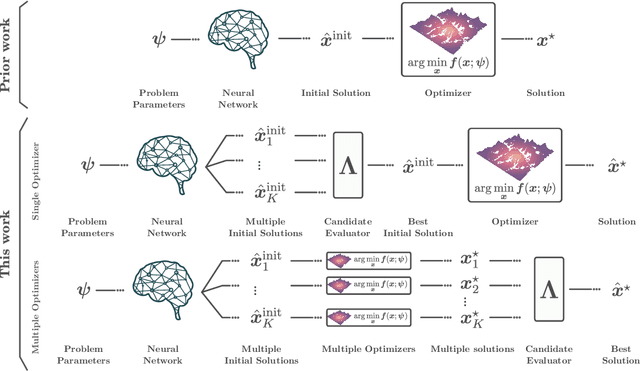

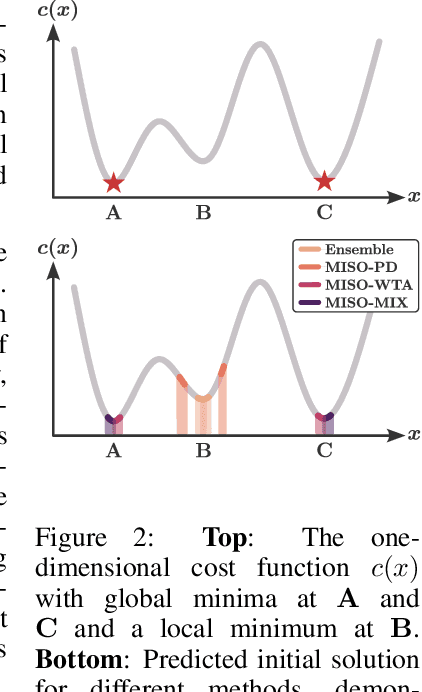

Abstract:Sequentially solving similar optimization problems under strict runtime constraints is essential for many applications, such as robot control, autonomous driving, and portfolio management. The performance of local optimization methods in these settings is sensitive to the initial solution: poor initialization can lead to slow convergence or suboptimal solutions. To address this challenge, we propose learning to predict \emph{multiple} diverse initial solutions given parameters that define the problem instance. We introduce two strategies for utilizing multiple initial solutions: (i) a single-optimizer approach, where the most promising initial solution is chosen using a selection function, and (ii) a multiple-optimizers approach, where several optimizers, potentially run in parallel, are each initialized with a different solution, with the best solution chosen afterward. We validate our method on three optimal control benchmark tasks: cart-pole, reacher, and autonomous driving, using different optimizers: DDP, MPPI, and iLQR. We find significant and consistent improvement with our method across all evaluation settings and demonstrate that it efficiently scales with the number of initial solutions required. The code is available at $\href{https://github.com/EladSharony/miso}{\tt{https://github.com/EladSharony/miso}}$.
LLaMA-Berry: Pairwise Optimization for O1-like Olympiad-Level Mathematical Reasoning
Oct 03, 2024



Abstract:This paper presents an advanced mathematical problem-solving framework, LLaMA-Berry, for enhancing the mathematical reasoning ability of Large Language Models (LLMs). The framework combines Monte Carlo Tree Search (MCTS) with iterative Self-Refine to optimize the reasoning path and utilizes a pairwise reward model to evaluate different paths globally. By leveraging the self-critic and rewriting capabilities of LLMs, Self-Refine applied to MCTS (SR-MCTS) overcomes the inefficiencies and limitations of conventional step-wise and greedy search algorithms by fostering a more efficient exploration of solution spaces. Pairwise Preference Reward Model~(PPRM), inspired by Reinforcement Learning from Human Feedback (RLHF), is then used to model pairwise preferences between solutions, utilizing an Enhanced Borda Count (EBC) method to synthesize these preferences into a global ranking score to find better answers. This approach addresses the challenges of scoring variability and non-independent distributions in mathematical reasoning tasks. The framework has been tested on general and advanced benchmarks, showing superior performance in terms of search efficiency and problem-solving capability compared to existing methods like ToT and rStar, particularly in complex Olympiad-level benchmarks, including GPQA, AIME24 and AMC23.
Parallelized Spatiotemporal Binding
Feb 26, 2024Abstract:While modern best practices advocate for scalable architectures that support long-range interactions, object-centric models are yet to fully embrace these architectures. In particular, existing object-centric models for handling sequential inputs, due to their reliance on RNN-based implementation, show poor stability and capacity and are slow to train on long sequences. We introduce Parallelizable Spatiotemporal Binder or PSB, the first temporally-parallelizable slot learning architecture for sequential inputs. Unlike conventional RNN-based approaches, PSB produces object-centric representations, known as slots, for all time-steps in parallel. This is achieved by refining the initial slots across all time-steps through a fixed number of layers equipped with causal attention. By capitalizing on the parallelism induced by our architecture, the proposed model exhibits a significant boost in efficiency. In experiments, we test PSB extensively as an encoder within an auto-encoding framework paired with a wide variety of decoder options. Compared to the state-of-the-art, our architecture demonstrates stable training on longer sequences, achieves parallelization that results in a 60% increase in training speed, and yields performance that is on par with or better on unsupervised 2D and 3D object-centric scene decomposition and understanding.
Learning from Teaching Regularization: Generalizable Correlations Should be Easy to Imitate
Feb 05, 2024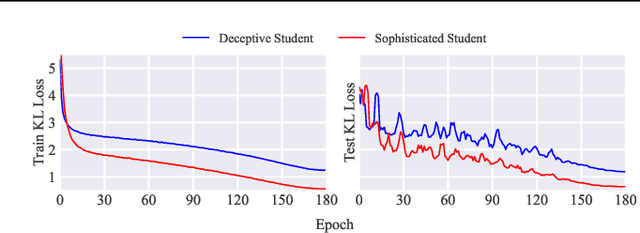

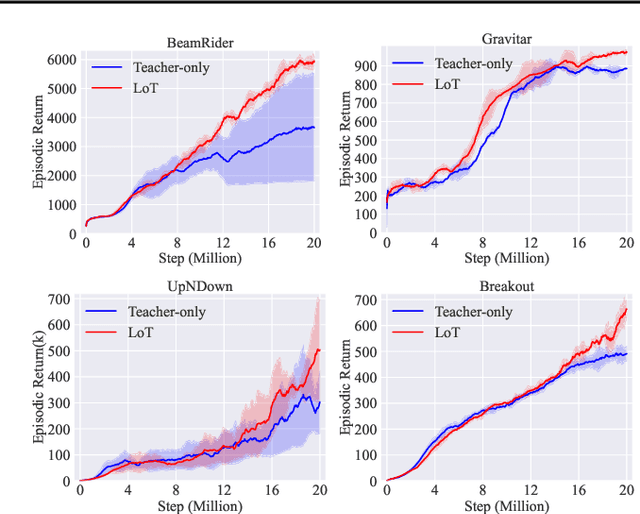
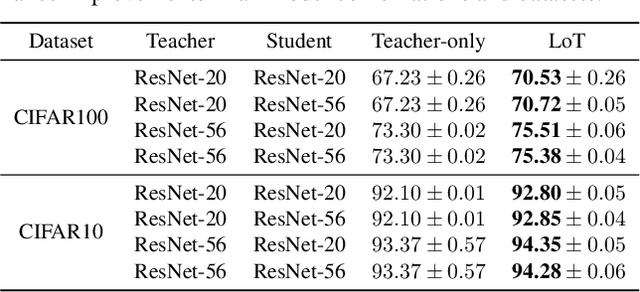
Abstract:Generalization remains a central challenge in machine learning. In this work, we propose Learning from Teaching (LoT), a novel regularization technique for deep neural networks to enhance generalization. Inspired by the human ability to capture concise and abstract patterns, we hypothesize that generalizable correlations are expected to be easier to teach. LoT operationalizes this concept to improve the generalization of the main model with auxiliary student learners. The student learners are trained by the main model and improve the main model to capture more generalizable and teachable correlations by providing feedback. Our experimental results across several domains, including Computer Vision, Natural Language Processing, and Reinforcement Learning, demonstrate that the introduction of LoT brings significant benefits compared to merely training models on the original training data. It suggests the effectiveness of LoT in identifying generalizable information without falling into the swamp of complex patterns in data, making LoT a valuable addition to the current machine learning frameworks.
EmerNeRF: Emergent Spatial-Temporal Scene Decomposition via Self-Supervision
Nov 03, 2023Abstract:We present EmerNeRF, a simple yet powerful approach for learning spatial-temporal representations of dynamic driving scenes. Grounded in neural fields, EmerNeRF simultaneously captures scene geometry, appearance, motion, and semantics via self-bootstrapping. EmerNeRF hinges upon two core components: First, it stratifies scenes into static and dynamic fields. This decomposition emerges purely from self-supervision, enabling our model to learn from general, in-the-wild data sources. Second, EmerNeRF parameterizes an induced flow field from the dynamic field and uses this flow field to further aggregate multi-frame features, amplifying the rendering precision of dynamic objects. Coupling these three fields (static, dynamic, and flow) enables EmerNeRF to represent highly-dynamic scenes self-sufficiently, without relying on ground truth object annotations or pre-trained models for dynamic object segmentation or optical flow estimation. Our method achieves state-of-the-art performance in sensor simulation, significantly outperforming previous methods when reconstructing static (+2.93 PSNR) and dynamic (+3.70 PSNR) scenes. In addition, to bolster EmerNeRF's semantic generalization, we lift 2D visual foundation model features into 4D space-time and address a general positional bias in modern Transformers, significantly boosting 3D perception performance (e.g., 37.50% relative improvement in occupancy prediction accuracy on average). Finally, we construct a diverse and challenging 120-sequence dataset to benchmark neural fields under extreme and highly-dynamic settings.
Bayesian Reparameterization of Reward-Conditioned Reinforcement Learning with Energy-based Models
May 18, 2023



Abstract:Recently, reward-conditioned reinforcement learning (RCRL) has gained popularity due to its simplicity, flexibility, and off-policy nature. However, we will show that current RCRL approaches are fundamentally limited and fail to address two critical challenges of RCRL -- improving generalization on high reward-to-go (RTG) inputs, and avoiding out-of-distribution (OOD) RTG queries during testing time. To address these challenges when training vanilla RCRL architectures, we propose Bayesian Reparameterized RCRL (BR-RCRL), a novel set of inductive biases for RCRL inspired by Bayes' theorem. BR-RCRL removes a core obstacle preventing vanilla RCRL from generalizing on high RTG inputs -- a tendency that the model treats different RTG inputs as independent values, which we term ``RTG Independence". BR-RCRL also allows us to design an accompanying adaptive inference method, which maximizes total returns while avoiding OOD queries that yield unpredictable behaviors in vanilla RCRL methods. We show that BR-RCRL achieves state-of-the-art performance on the Gym-Mujoco and Atari offline RL benchmarks, improving upon vanilla RCRL by up to 11%.
SPE: Symmetrical Prompt Enhancement for Fact Probing
Nov 14, 2022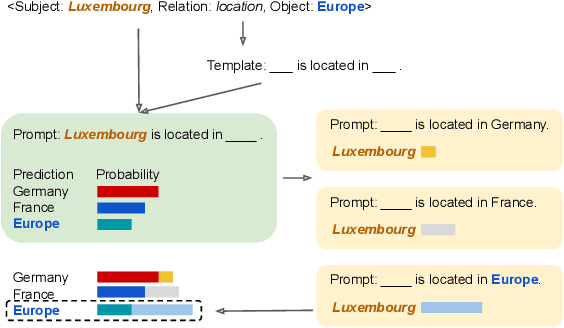

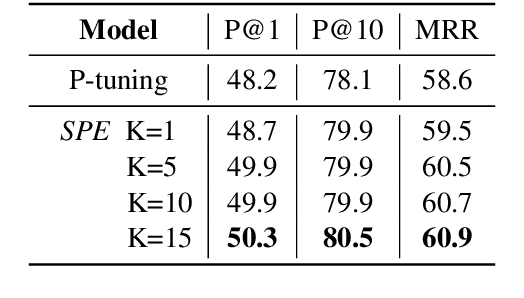
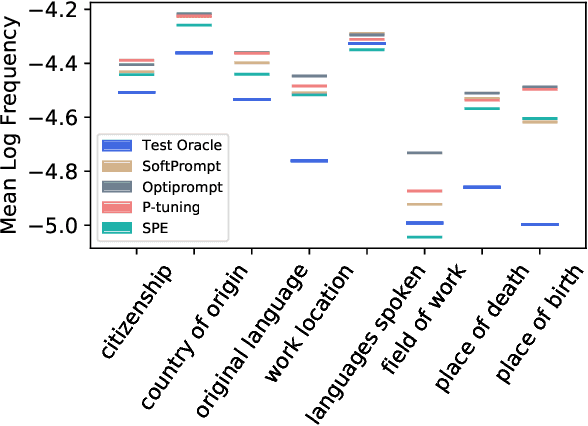
Abstract:Pretrained language models (PLMs) have been shown to accumulate factual knowledge during pretrainingng (Petroni et al., 2019). Recent works probe PLMs for the extent of this knowledge through prompts either in discrete or continuous forms. However, these methods do not consider symmetry of the task: object prediction and subject prediction. In this work, we propose Symmetrical Prompt Enhancement (SPE), a continuous prompt-based method for factual probing in PLMs that leverages the symmetry of the task by constructing symmetrical prompts for subject and object prediction. Our results on a popular factual probing dataset, LAMA, show significant improvement of SPE over previous probing methods.
 Add to Chrome
Add to Chrome Add to Firefox
Add to Firefox Add to Edge
Add to Edge